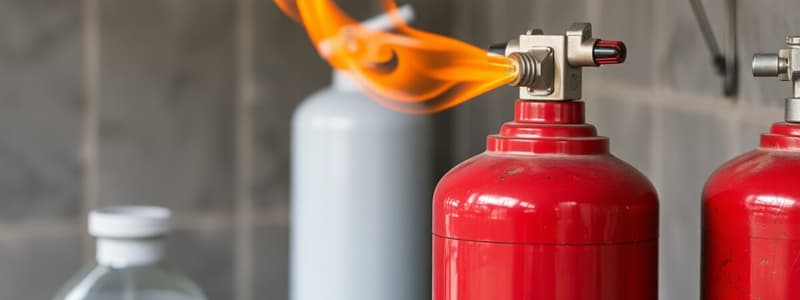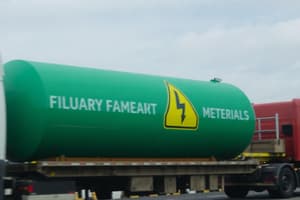Podcast
Questions and Answers
What is the flash point threshold for a liquid to be classified as flammable?
What is the flash point threshold for a liquid to be classified as flammable?
- Below 73°F (22.8°C) (correct)
- At or below 60°F (15.6°C)
- Below 37.8°F (3.2°C)
- At or above 100°F (37.8°C)
Which class of flammable liquid has a flash point below 73°F and a boiling point at or above 100°F?
Which class of flammable liquid has a flash point below 73°F and a boiling point at or above 100°F?
- Class IA
- Class II
- Class IC
- Class IB (correct)
What class of combustible liquid has a flash point at or above 200°F (93°C)?
What class of combustible liquid has a flash point at or above 200°F (93°C)?
- Class II
- Class IIIB (correct)
- Class IIIA
- Class IC
Which of the following defines a combustible liquid according to the Department of Transportation (DOT)?
Which of the following defines a combustible liquid according to the Department of Transportation (DOT)?
According to the EPA, which of the following criteria determines if waste is hazardous due to ignitability?
According to the EPA, which of the following criteria determines if waste is hazardous due to ignitability?
Which class of liquids has a flash point at or above 140°F but below 200°F?
Which class of liquids has a flash point at or above 140°F but below 200°F?
What is the appropriate term used by the EPA in the Resource Conservation and Recovery Act to refer to ignitable solids?
What is the appropriate term used by the EPA in the Resource Conservation and Recovery Act to refer to ignitable solids?
What does a flash point below 73°F (22.8°C) classify a liquid as?
What does a flash point below 73°F (22.8°C) classify a liquid as?
Which of the following defines a flammable solid according to OSHA?
Which of the following defines a flammable solid according to OSHA?
What is the definition of the flash point of a liquid?
What is the definition of the flash point of a liquid?
At what temperature does NFPA 400 consider a solid to be flammable?
At what temperature does NFPA 400 consider a solid to be flammable?
Which statement correctly defines flammable gas according to DOT?
Which statement correctly defines flammable gas according to DOT?
Which flash point category includes liquids with a flash point below 23°C and an initial boiling point below or equal to 35°C?
Which flash point category includes liquids with a flash point below 23°C and an initial boiling point below or equal to 35°C?
What is a characteristic of pyrophoric materials?
What is a characteristic of pyrophoric materials?
According to OSHA, how is a Category 3 flammable liquid defined?
According to OSHA, how is a Category 3 flammable liquid defined?
Which of the following statements is true regarding the GHS and OSHA classification systems?
Which of the following statements is true regarding the GHS and OSHA classification systems?
Which of the following materials would be classified as a pyrophoric material?
Which of the following materials would be classified as a pyrophoric material?
What is the primary basis for defining flammability and combustibility in regulatory frameworks?
What is the primary basis for defining flammability and combustibility in regulatory frameworks?
What is the definition of a self-heating material according to DOT?
What is the definition of a self-heating material according to DOT?
What type of hazard class does DOT assign to flammable solids?
What type of hazard class does DOT assign to flammable solids?
What aspect of halons contributes to their replacement by ozone-friendly materials?
What aspect of halons contributes to their replacement by ozone-friendly materials?
Which condition must a flammable gas meet according to OSHA?
Which condition must a flammable gas meet according to OSHA?
Which of these options describes regulatory variations in the classification of flammable materials?
Which of these options describes regulatory variations in the classification of flammable materials?
What is the distinguishing feature between Category 1 and Category 4 flammable liquids under GHS regulations?
What is the distinguishing feature between Category 1 and Category 4 flammable liquids under GHS regulations?
What is the lower flammability limit (LFL)?
What is the lower flammability limit (LFL)?
Why is it important to understand the flammability limits of materials?
Why is it important to understand the flammability limits of materials?
What does a high vapor pressure indicate about a substance?
What does a high vapor pressure indicate about a substance?
What is vapor density and why is it important?
What is vapor density and why is it important?
What does a specific gravity of less than 1 indicate about a liquid?
What does a specific gravity of less than 1 indicate about a liquid?
What is the autoignition temperature?
What is the autoignition temperature?
How does knowledge of flammability limits aid in fire safety?
How does knowledge of flammability limits aid in fire safety?
Which of the following substances would likely have a vapor density greater than 1?
Which of the following substances would likely have a vapor density greater than 1?
Which of the following best defines a flammable substance?
Which of the following best defines a flammable substance?
What is the fourth component of the fire tetrahedron?
What is the fourth component of the fire tetrahedron?
How can removing fuel prevent a fire?
How can removing fuel prevent a fire?
Which method effectively interrupts the chemical reaction that sustains combustion?
Which method effectively interrupts the chemical reaction that sustains combustion?
What role do PFAS play in firefighting foam?
What role do PFAS play in firefighting foam?
What happens when free radicals are removed during combustion?
What happens when free radicals are removed during combustion?
The fire tetrahedron differs from the fire triangle by including which additional component?
The fire tetrahedron differs from the fire triangle by including which additional component?
Which substance is known for interrupting the combustion process by disrupting the chemical chain reaction?
Which substance is known for interrupting the combustion process by disrupting the chemical chain reaction?
Flashcards
Flammable Substance
Flammable Substance
A material that ignites easily and burns rapidly when exposed to an ignition source. Examples include gasoline, alcohol, and natural gas.
Combustible Substance
Combustible Substance
A material that is more difficult to ignite than a flammable substance, but still burns rapidly once ignited. Examples include wood, paper, and cloth.
Fire Triangle
Fire Triangle
A model that shows the three essential elements needed for fire: fuel, oxygen, and heat.
Fire Tetrahedron
Fire Tetrahedron
Signup and view all the flashcards
Chemical Chain Reaction
Chemical Chain Reaction
Signup and view all the flashcards
Fire Suppression Strategies
Fire Suppression Strategies
Signup and view all the flashcards
PFAS in Firefighting
PFAS in Firefighting
Signup and view all the flashcards
Halon Fire Extinguishers
Halon Fire Extinguishers
Signup and view all the flashcards
Flammable Liquid
Flammable Liquid
Signup and view all the flashcards
Flash Point
Flash Point
Signup and view all the flashcards
Class IA Flammable Liquid
Class IA Flammable Liquid
Signup and view all the flashcards
Class IB Flammable Liquid
Class IB Flammable Liquid
Signup and view all the flashcards
Class IC Flammable Liquid
Class IC Flammable Liquid
Signup and view all the flashcards
Combustible Liquid
Combustible Liquid
Signup and view all the flashcards
DOT Class 3
DOT Class 3
Signup and view all the flashcards
Ignitable Waste
Ignitable Waste
Signup and view all the flashcards
Open-Cup Flash Point
Open-Cup Flash Point
Signup and view all the flashcards
Closed-Cup Flash Point
Closed-Cup Flash Point
Signup and view all the flashcards
OSHA Flammable Liquid Categories
OSHA Flammable Liquid Categories
Signup and view all the flashcards
GHS Flammable Liquid Categories
GHS Flammable Liquid Categories
Signup and view all the flashcards
NFPA 704 Flammable Liquid Categories
NFPA 704 Flammable Liquid Categories
Signup and view all the flashcards
Flammability Limits
Flammability Limits
Signup and view all the flashcards
Lower Flammability Limit (LFL)
Lower Flammability Limit (LFL)
Signup and view all the flashcards
Upper Flammability Limit (UFL)
Upper Flammability Limit (UFL)
Signup and view all the flashcards
Vapor Pressure
Vapor Pressure
Signup and view all the flashcards
Specific Gravity
Specific Gravity
Signup and view all the flashcards
Autoignition Temperature
Autoignition Temperature
Signup and view all the flashcards
Flammable Solid
Flammable Solid
Signup and view all the flashcards
Readily Combustible Solid
Readily Combustible Solid
Signup and view all the flashcards
Flammable Gas
Flammable Gas
Signup and view all the flashcards
Pyrophoric Material
Pyrophoric Material
Signup and view all the flashcards
What are some examples of Pyrophoric Materials?
What are some examples of Pyrophoric Materials?
Signup and view all the flashcards
Self-Heating Material
Self-Heating Material
Signup and view all the flashcards
What is a common example of a self-heating material that can lead to combustion?
What is a common example of a self-heating material that can lead to combustion?
Signup and view all the flashcards
What is the DOT's definition of a flammable solid?
What is the DOT's definition of a flammable solid?
Signup and view all the flashcards
Study Notes
Flammable Materials
- Flammable substances ignite easily, rapidly burning or combusting when exposed to an ignition source.
- Combustible substances are harder to ignite but still burn readily when ignited.
- Combustion requires four components: fuel, oxygen, heat, and a chemical reaction.
- The fire triangle (fuel, oxygen, heat) is an outdated model.
- The fire tetrahedron (fuel, oxygen, heat, chemical reaction) describes modern understanding of fire.
Fire Suppression Strategies
- Removing fuel prevents the fire from consuming further resources.
- Reducing heat lowers the temperature below the ignition point.
- Limiting oxygen prevents the fire from burning.
- Interrupting the chain reaction, using agents like dry chemical powders or halons, stops the fire.
Flammable Liquids
- Flash point is the minimum temperature for a liquid to produce ignitable vapors.
- Open-cup and closed-cup methods measure flash points.
- OSHA categorizes flammable liquids based on flash and boiling points.
- Lower category numbers indicate higher hazard.
Classifications of Flammable Liquids
- NFPA 30 classifies flammable liquids based on flash point and boiling point into classes IA, IB, IC.
- Combustible liquids have flash points above 100°F (37.8°C) and are further divided into classes (II, IIIA, IIIB).
Flammable Solids
- OSHA defines a flammable solid as a readily combustible solid that ignites easily from friction or retained heat.
- They are particularly hazardous due to rapid ignition and spread.
Pyrophoric Materials
- Pyrophoric materials ignite spontaneously in contact with air.
- Self-heating materials generate sufficient heat to ignite without external sources.
Other Important Factors
- Lower and Upper Flammability Limits (LFL, UFL): The concentration range of a flammable gas in air that will burn when ignited. LFL is the minimum concentration for ignition, UFL is the maximum for ignition to continue.
- Vapor Pressure: Measure of a substance's tendency to vaporize at a given temperature. High vapor pressure materials risk igniting easily.
- Vapor Density: Comparison of a vapor's weight to an equal volume of air. Vapors with density more than 1 sink and can accumulate igniting easily.
- Autoignition Temperature: Lowest temperature needed for a substance to self-ignite without an external ignition source. Low autoignition temperatures mean the risk is higher.
Studying That Suits You
Use AI to generate personalized quizzes and flashcards to suit your learning preferences.
Related Documents
Description
Test your knowledge on flammable materials and effective fire suppression strategies. This quiz covers the characteristics of combustible substances, the fire tetrahedron, and how to control fires safely. Dive into important concepts like flash points and the methods for measuring them.



